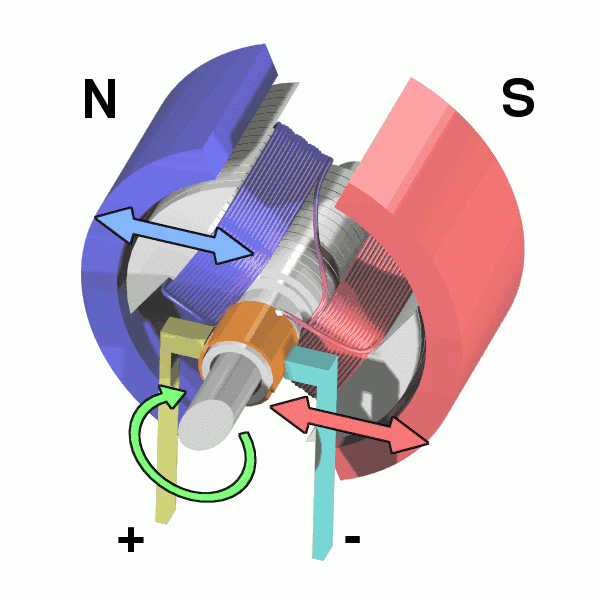Service hotline
+86 0755-83044319
release time:2022-03-17Author source:SlkorBrowse:9960
The commonly used principle of DC motor is electro-magnetism: the electrified wire will generate a magnetic field.That is, the electromagnetic induction rotating magnetic field drives the rotor to rotate.The motor is composed of a stator and a rotor, one of which generates a rotating magnetic field and the other is a magnetic pole, and the rotor (bearing) of the motor rotates.This realizes the conversion of electric energy-> magnetic energy-> mechanical energy.
The following figure can be understood more intuitively:

PWM principle
Please refer to this article about the principle of PWM: PWM principle and its application.
As we know from the above, controlling the motor speed by PWM is actually realized by controlling the power supply current.
The force on a conducting wire in a magnetic field is called ampere force, and the formula of ampere force: F=BIL.
Where f is the stress, I is the current, and L is the wire length. Under the condition that other conditions are constant, controlling the current through it means controlling the ampere force.
The resistance r of the motor is basically constant, then the current I = U/R and F= BLU/R ..
In the case of constant R B L, the essence of controlling the ampere force is to modify the power supply voltage.
We also know that the essence of controlling the motor speed is to supply different power supply voltages to the motor. The bigger the voltage, the faster the motor speed.
The essence of PWM is pulse width modulation, which converts DC voltage into analog signals with different voltage values by outputting different duty ratios.
Control motor speed
As we know, the duty ratio is the ratio of high level in a cycle, and the greater the ratio of high level, the greater the duty ratio. For DC motors, the output pin of the motor is a high-level motor, so it can rotate. When the output is high, the motor will rotate, but it will speed up little by little. When the high level suddenly turns to the low level, the motor will not stop because the inductance has the function of preventing the current from suddenly changing. Will keep the original speed, and so on and so forth, the speed of the motor is the average voltage output in the cycle, so in essence, our speed regulation is to keep the motor in a state of stopping, not stopping, rotating at full speed and not rotating at full speed, so the average speed in a cycle is the speed adjusted by our duty ratio.
summary
In motor control, the higher the voltage, the faster the motor speed.
By outputting different analog voltages through PWM, the motor can reach different output speeds.
Of course, in motor control, different motors have their own adaptive frequencies. If the frequency is too low, the motion will be unstable. If the frequency is just within the range of human hearing, sometimes the whistling sound will be heard.
The motor with too high frequency may not be able to respond, and the normal motor frequency should be 6-16kHZ.
The output voltage is different, and the motor speed is different. We can know that the motor speed can be adjusted by sliding the rheostat or changing the power supply with different voltages, but PWM is obviously more convenient in practical application.To be professional, this is:The so-called PWM is the pulse width modulator, which provides the motor with a pulse with a certain frequency and adjustable pulse width.
The larger the pulse width, that is, the larger the duty ratio, the larger the average voltage supplied to the motor, and the higher the motor speed.
Conversely, the smaller the pulse width, the smaller the duty cycle. The smaller the average voltage supplied to the motor, the lower the motor speed.
Disclaimer: This article is reproduced from "Hardware Attacking the City Lion". This article only represents the author's personal views, and does not represent the views of Sacco Micro and the industry. It is only for reprinting and sharing to support the protection of intellectual property rights. Please indicate the original source and author when reprinting. If there is any infringement, please contact us to delete it.
Company Tel: +86-0755-83044319
Fax/fax:+86-0755-83975897
Email: 1615456225@qq.com
QQ: 3518641314 Manager Li
QQ: 332496225 Manager Qiu
Address: Room 809, Block C, Zhantao Technology Building, No.1079 Minzhi Avenue, Longhua New District, Shenzhen









Site Map | 萨科微 | 金航标 | Slkor | Kinghelm
RU | FR | DE | IT | ES | PT | JA | KO | AR | TR | TH | MS | VI | MG | FA | ZH-TW | HR | BG | SD| GD | SN | SM | PS | LB | KY | KU | HAW | CO | AM | UZ | TG | SU | ST | ML | KK | NY | ZU | YO | TE | TA | SO| PA| NE | MN | MI | LA | LO | KM | KN
| JW | IG | HMN | HA | EO | CEB | BS | BN | UR | HT | KA | EU | AZ | HY | YI |MK | IS | BE | CY | GA | SW | SV | AF | FA | TR | TH | MT | HU | GL | ET | NL | DA | CS | FI | EL | HI | NO | PL | RO | CA | TL | IW | LV | ID | LT | SR | SQ | SL | UK
Copyright ©2015-2025 Shenzhen Slkor Micro Semicon Co., Ltd